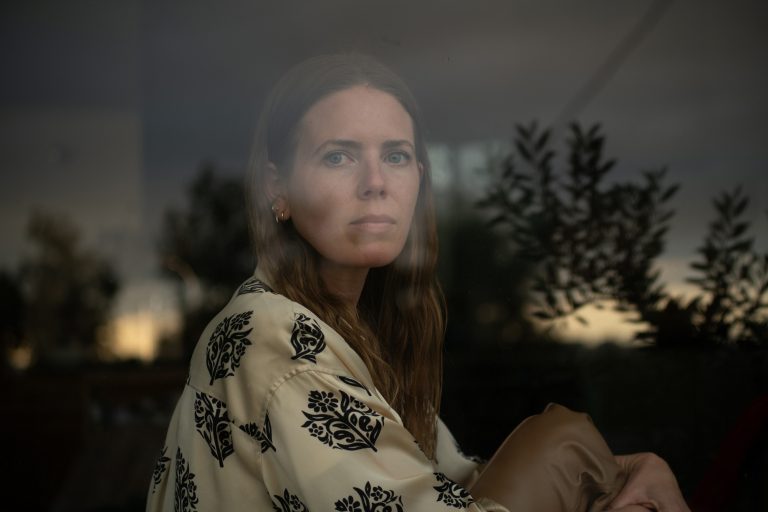
To Dress People Like Her
Updated: 2024/01/02
- Interview
- Brit Marling
BRIT MARLING: I'm here with Megan Gray. I'm going to tell a short story to begin: our creative collaboration began on the set of I Origins, a movie directed by Mike Cahill. Megan was costume designing the film. I remember the two of us going so deep into my character, Karen. Megan thought of every little detail: what the glasses were going to be, what the shoes were going to be, and everything came from this deep study of character. I was so blown away by Megan, because it was a small independent film, and there weren't that many people working on it. In any given moment, Megan was doing 10,000 things. She was costume designing, she was actor wrangling. She was pulling the whole set together. She was also supporting the entire production.
And I thought, ‘this person is incredible’. So after that I asked Megan if she would be my stylist, and we started doing that together for a while. And then our first collaboration was the second season of OA, which I had written and was making. Just one highlight from that was this velvet, burgundy spaceship Gucci dress, which Nina Azarova wears to on a night out on the town. It was so iconic that people often send me needlepoint stitchings of the dress.
MEGAN GRAY: I love that.
So to make a long story short, it's been a long and fruitful collaboration and now Megan's stepping into the role of the full costume designer for Murder at the End of the World. It’s a really challenging story, because there's so many characters, it's a whodunnit. But before we get to that, I want to go back to the beginning. What was the moment that you fell in love with clothing and fashion? How old were you? How did it happen?
My great-grandmother came to Grandparents' Day in kindergarten when I was in kindergarten, so I was like five, and she came in a gold lame outfit and high heels. And at that time she was maybe late sixties, but she was my great grandmother and I was like, this woman is fantastic and I want to dress people like her. And I put Legos in my socks to make them high heels. I would go and try to steal any clothing I could from my mom's closet, and I always knew it was the path that I would go down. I made my homecoming dresses and prom dresses.
Alright. Describe what your most iconic homecoming prom dress looked like.
I used this iridescent chiffon, that was purple and teal. Looking back, not my finest choice, but my mom would bring me up to LA to pick out fabric and then I found a woman who I would sketch it and tell her what I wanted and she helped me sew it and put it all together.
I always knew it was what I wanted to do, which I think scared my parents, because my parents aren't in a creative field. But I knew that I didn't need a backup, that I was going to figure it out. And then I met you.
How did you take your first steps into styling and costume designing? What did that look like?
When I graduated from college, I worked for a small designer here in Los Angeles. And then I moved to New York and designed at Ralph Lauren. And then I met someone at Conde Nast and I decided at 26 to leave design and go into styling. And I started at the bottom. I was an intern and then a first assistant, and then I got my first few clients and was doing commercial work. And [then] Mike asked me about I Origins.
So that was your first costume design job?
My very first.
You could not tell it was your first job.
I had no idea what I was doing. Oh, I remember Michael Pitt dropped his glasses down the elevator shaft and Hunter looked at me and said, ‘go grab the other pair’. And I said, ‘What other pair? Those are the only pair.’ And everyone looked at me, like ‘how can you not have a double?’ I'm like, ‘what is a double?’ We found them magically and I've learned many things along the way, but I also after that knew this is what I wanted to do. So I started assisting and I'm very fortunate. I assisted some amazing designers who really taught me everything and have been in my corner since. If I need help with anything, I call them. And they're all female and amazing. Some are moms and some are not. And there's just this beautiful thing of working with who empower each other. I've always had that with you – people who are my mentors. And that to me is really special.
What's the most valuable thing you think you learned from a mentor about designing?
I would say between both Megan Casper and Lindsay Pugh, Megan always told me to trust my instinct. Lindsay always pushed me to go a bit further. Lindsay and I did The Matrix Resurrections together, which is such a hard thing to come in to. The Matrix is so iconic, and it was left for 20 years, and then you're redoing it and you're a new designer who didn't do the originals. She went down into what would Neo have in his pocket, what makes him who he is? And she really let the actors talk about their backstory and who they were. And I saw then oh, it's so important. The actor has done so much more homework than we have in terms of who they were as a child, and what their parents did for a living. One actor I worked with, he even knew what photo he would have on his phone.
When you allow collaboration, [what] you can come up with, I think is so much deeper. That was a big thing.
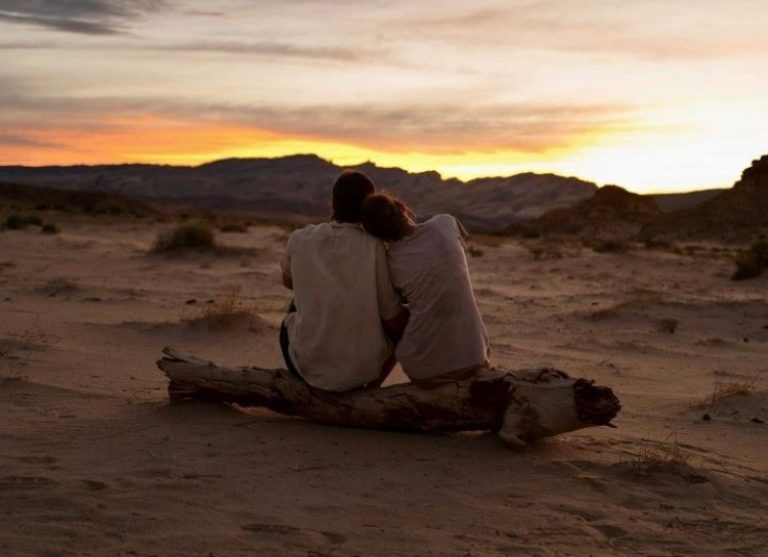
Still from A Murder at the End of the World.
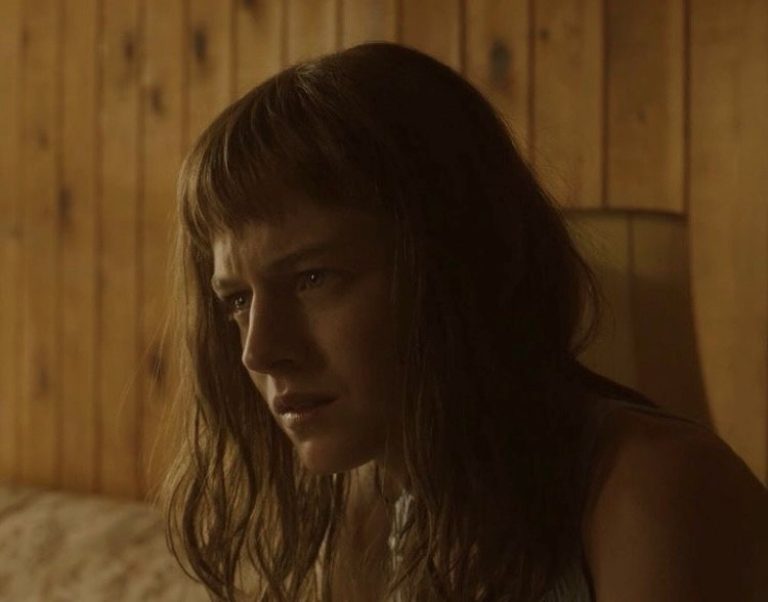
Still from A Murder at the End of the World.
Something that really strikes me about your work as a designer is that you don't have ego about it. You are really excited to meet an actor where they're at in their homework and their process of creating a character, and to then merge and create together. I have felt that so many times with you, and it's really an amazing experience because you care even about what's not on screen. I could be saying, ‘I feel like for this character I have a wedding ring, but it's not on my finger. It's on a long chain around my neck and I wear it under my costume’ and I've seen you go source that necklace and that ring. And it's for the actor to help the actor with their performance. It's not even about in that moment what is seen, which to me is so beautiful because as a designer, it's like you're working from the inside out. I don't think most people think about all those layers.
I love actors and I think the work that they do is so important and the stories that they tell. I remember when [actor] Clive Owen and I we had our first Zoom and we were really trying to understand who he would be. We came up with this idea that you should feel his presence without seeing him on camera. And that was so important that we could then establish what the silhouette would be when it was on camera. So we worked in such a different way. All actors do – Emma Corrin is so playful, and they come into a room and they will try anything on. It was such a beautiful cast.
I remember when you delivered those first sheets of Emma dressed as Darby. There were maybe 200 images of Emma in different costumes. And then there was one shot you'd done of her – you'd found a vintage slip that was just above the knee with sneakers, and like a beat up T-shirt on top. It was like Darby appeared all of a sudden.
Which is so fun, I can tell when it's right with you guys. And then there were characters that we had to work harder on, which I think that challenge only brings more to the character and you really get into it. I think having an ego about it is such a bizarre thing because it's a creative process and if you're collaborating and you have an ego, you're closing yourself off to what someone can bring into the space. My team was so amazing. Alyssa, my assistant, had so many great ideas and it was never about who came up with what. It was just, it was a melting pot of throw it all in there, let's see what sticks and let's find those characters. And having the parameters of a colour palette at first is very frightening.
Oh my God. We should pause for a second to say, one day I called Megan and I was like, ‘We're going to stick to a really strict colour rule book. In Iceland it will only be colours of ice, so blues, aquas, greys, and then blood on that ice.’ So red could be there, and blushes of the sky. But that was it. And in the past it was like, ‘there could be some cyan and then it's got to be the dust yellows of the desert and the reds of the desert.’ But green was forbidden, yellow was forbidden, orange was forbidden…and Megan likes a good orange.
I do. I love a good neon green, too.
So, when I first came to Megan, her jaw just dropped and she was like, ‘wait, what? We're taking all green, all orange, all yellow out?.’ But I remember coming down to your costume centre, which was on a sound stage in New Jersey. I was walking in a labyrinth of racks that were two stories high and it was all shades of red, shades of blue, shades of blush, shades of grey. It felt like being surrounded by the world of the show. And now it's funny because when you see a still frame of A Murder at the End of the World, you're like, ‘That's from A Murder at the End of the World’, because of that tonal control. But the fact that you managed to outfit 12 guests at a dinner scene and never touch on any of those other colours is a damn miracle on the budget we were operating on.
We were so set on making a whodunit that felt grounded and real, a whodunit that wasn't tongue in cheek, that you could really believe in, which means the characters had to be earth bound, and yet they had to be distinct. I felt like in some ways you had the most challenging job, because that's not an easy thing to straddle. I think we did it. I really believe in it.
Darby was such a hard character to crack because I remember you had a photo on your initial mood board, of a girl in a slip dress. We wanted to capture this femininity, this vulnerability and softness of Darby in a way in 2016. But also there's the level of her being raised by her dad, and what influenced does not having her mom be there have? And then what would she look like after losing the love of her life? What shell, what walls does she put up? That was a really fun and interesting world to have to create and find that balance with. But also, Darby's from Middle America. So it needed to feel real.
You can't just be like [wearing] The Row.
She’s not living in that space. It's thrift shopping. It's maybe taking something of her dad's and cuffing it up and making it feel grounded. But I think having those really grounded, deep rooted shows are so beautiful because even if the costumes aren't talking, sometimes when they're quiet, they say more.
Which is life, in the sense that sometimes you have a night where you want to dress loud and your mood is loud, and then you have a night when you kind of want to recede and be the spy. Can you tell me in life as a person, or even when you're working on a project, where you go for inspiration? How do you get yourself in the mood? What are things that make you feel connected to your creative wellspring?
I really enjoy going to flea markets and thrift shops. I love digging in boxes. I love just sitting and watching people because it is real. I think the span of all of these different generations. and how 20-year-olds right now are using shoelaces in certain ways to tie their belts, which people did in the 1990s and early 2000s but they're doing it differently.
I think travelling is so important, being in Europe…if you have the ability to go to Japan and just see how different people are putting things together…then magazines and old movies and TV shows and museums and just being around other creative energy, is what really helps me. Watching people get dressed. Everything is so thought out: people say, ‘oh, I just put this on’. I'm like, ‘but there was a reason you put it on.’, Even if you weren't consciously thinking, ‘I'm going to wear that shoe’, you chose that shoe. I think that that is such an important thing.
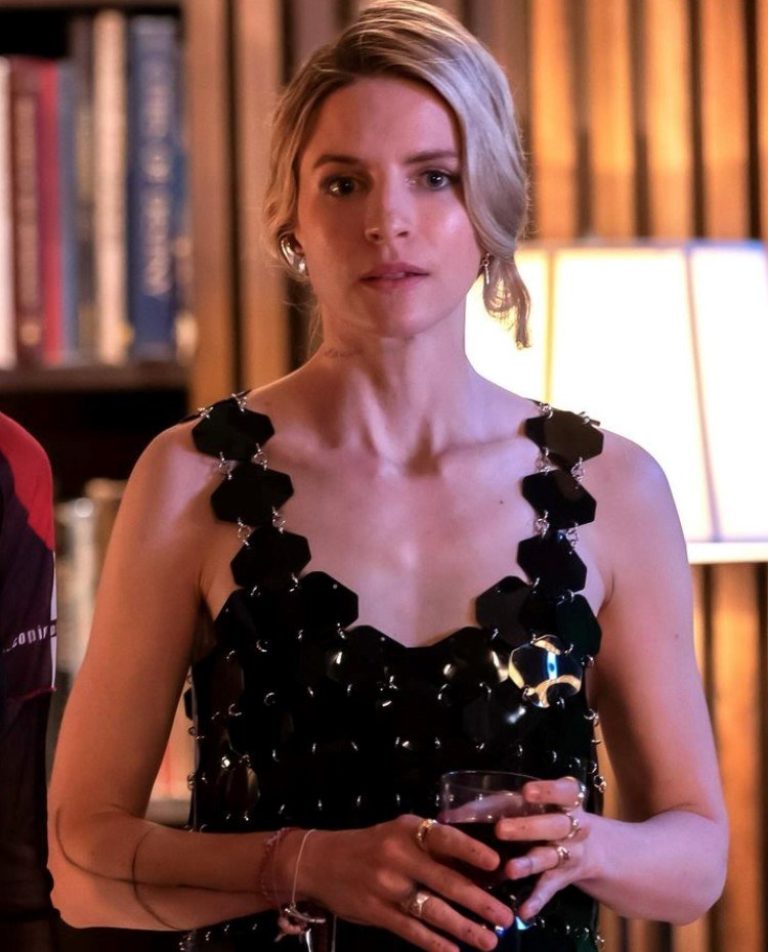
Still from A Murder at the End of the World.
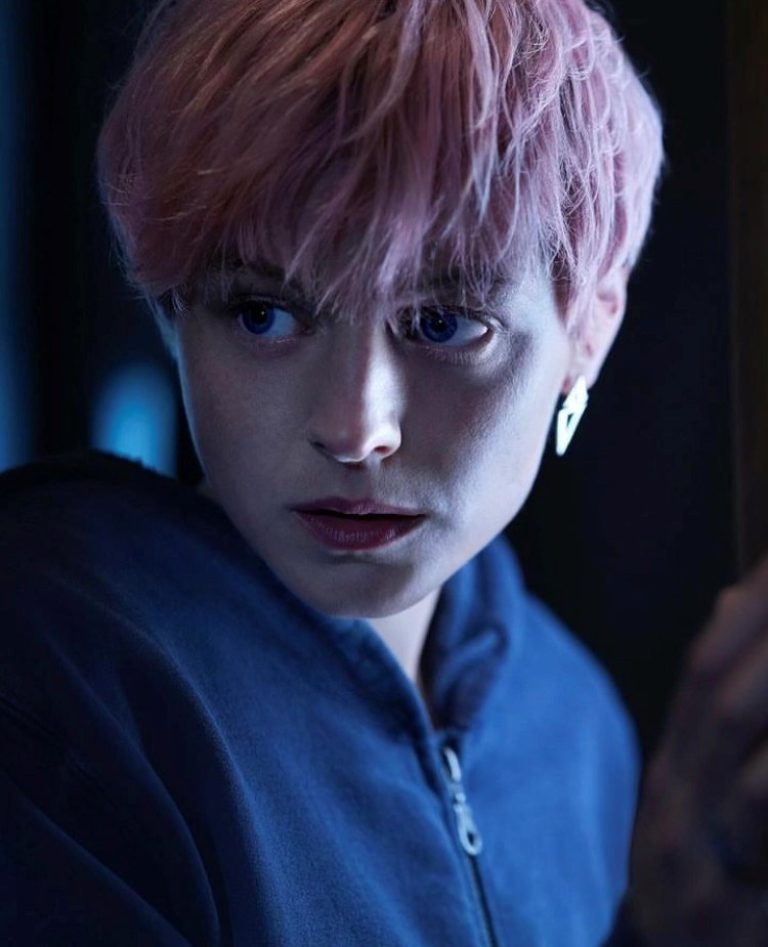
Still from A Murder at the End of the World.
I love what you're saying. I remember I had a point in my life where I was like, am I paying too much attention to fashion? Am I lost down a kind of consumerist rabbit hole? And then I remember watching this video about bowerbirds. They are these birds that decorate their nests so beautifully, and they're sometimes on the ground. One of the bowerbirds was obsessed with blue. So it had laid out all these blueberries in this pattern, but then also blue plastic, blue Bic pen tops and blue tinsel, and had made this elaborate array of his presentation of his home, which I guess is a part of the bird’s mating ritual. But I remember seeing that and realizing that actually, all of nature has the instinct or impulse to display, or to invent or to be creative in display, whether that's how you lay out your house or your table where you feed people, or the vintage T-shirt you put on in the morning with what beat up pair of sneakers.
There is something about, as you're saying, a communication of what you're feeling on the inside, [and] a desire to decorate and to express that outside which is I think, a really beautiful impulse. So yeah, all that to say, I really understand, and I have seen you do this, and you did this on this show. I remember you telling me that everyone on the costume team had gone to a vintage warehouse In New Jersey where you guys were just literally sorting through garbage bag after garbage bag, dumping 'em out all over the floor.
It's the greatest. You get dirty in your bins. I mean, I will climb into a bin and get in there. That’s where one of Darby's sweatshirts is from. It's from a bin, and I think it was like $3 or something. Also when you're creating a show that's so big, being able to also use old clothing, vintage clothing is so great in terms of not adding to the show’s carbon footprint.
A lot of costume designers get really panicked about the rules part of the job sometimes, which is like, ‘I need to have five multiples of this item of clothing’. You're always much bolder as a designer. You'll be like, ‘it's going to be okay. We have the one dress. That's it. We're going to watch out for it and it's going to be okay.’ I think everybody finds that so cool and appreciates that so much, right? A texture of the real enters, but also the project’s ecological footprint becomes more manageable.
Joan Chen's character wears really amazing vintage, and Lee has vintage pieces, and I think you have to. You can't recreate the perfectly worn in t-shirt.
It doesn't work. Time does something to close that nothing else can do. You need someone to wear it for 10 years and sweat in it and put it in the washer and the dryer.
– and wash it horribly and crumple it. That's what makes it real. And sometimes you just have to cross your fingers and tell the actor, you're not allowed to eat lunch in this and do not sit on the ground in this. We have one, but it's the perfect one, and you just go with it. And it works, I think.
I have one last question. Is there anything for young women who might be interested in a career of styling or costume designing or any kind of design, is there anything that you would say as a piece of advice for navigating that world or things that you've learned along the way that you think are valuable that took some time to learn or?
Never be afraid to get your hands dirty, and to take every job and to not be afraid to ask questions if you don't know something. When you have a moment, go and sit with a seamstress. You're not going to know everything, especially when you're starting out. And it's okay not to know everything. The more you can learn and the more open you are to even to sit and talk with a DP or someone about lighting, to understand how, oh, this kind of fabric will absorb that light. Really just try to explore everything. Trust your intuition. It's not an easy, glamorous job all the time, but it's so rewarding to tell stories.
And if you can find people like you and Zal to be in your space and to be able to tell stories…there's times that I'm like, ‘oh, my mom's a labour and delivery nurse, and my dad is a junior high principal.’ But I'm bringing joy and we're bringing truth, and we're bringing entertainment and laughter and tears into people's lives. And if that is the path you want to go in, that's the path you should take. Don't let anyone make you feel anything about that, because it's a beautiful thing to be able to tell stories and to be a part of that. I think I would just tell them, keep going. And women, we really can change the world. I think we really do, every day. Be a part of the bigger story of your life that you want to tell. I feel very fortunate that I've had a lot of strong women along the way who've told me to keep going and to be on the same team, just to be together. I think we don't do that enough.
Okay, nobody can see this, but I'm tearing up. We need to just keep telling stories and be together.
Yes.
That was exquisite. Megan. Thank you.
Related Articles

The Dust Would Catch the Light

Liberty 150 x150 curated by Leith Clark: The Founder Interviews

Liberty 150 x150 curated by Leith Clark: The Founder Interviews

Liberty 150 x150 curated by Leith Clark: The Founder Interviews



